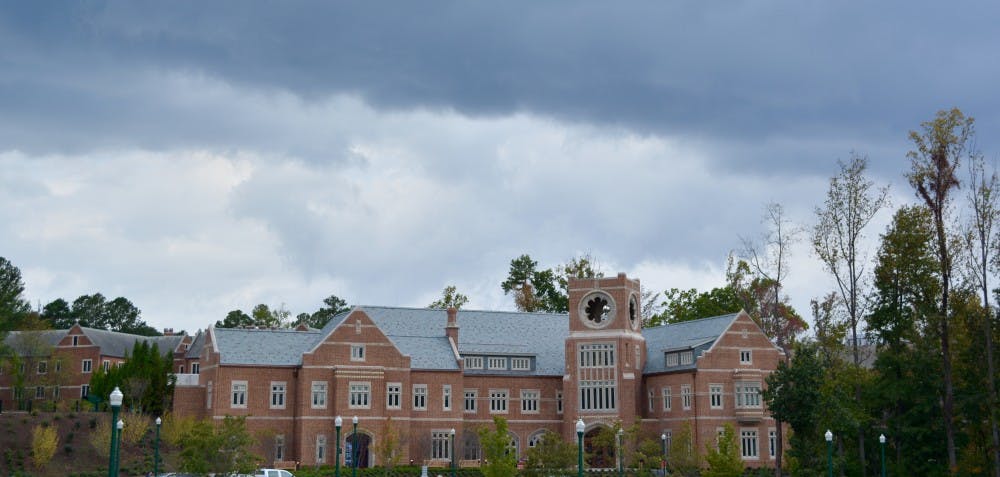Over 15 percent of students at the University of Richmond come from the top 1 percent of the income scale, compared to 20 percent of students that come from the entire bottom 60 percent of the scale, according to a recent study.
The study, by the Equality of Opportunity Project, examined anonymous data from tax returns, including graduated students’ incomes in their early thirties and their parents’ incomes. The data covered all college students in the United States from 1999 to 2013.
Overall, Richmond is the 64th college in the nation with the highest number of students coming from the top 1 percent, meaning their family income is $630,000 or more.
Washington and Lee University, in Lexington, Virginia, is ranked third. There, top 1 percent students outnumber students coming from the bottom 60 percent by almost 8 percent.
In the state of Virginia, Richmond has the second highest number of top 1 percent students, only behind Washington and Lee.
One of the reasons high-income students may choose Richmond is because they have been given more information throughout their college search process, Stephanie Dupaul, vice president for enrollment management, said. Those students often attend private high schools with college counselors that have more time to spend with each student, she said.
“I think that environment creates an opportunity for students in the higher-income brackets to know more about schools like Richmond, which might not be as visible to students who don’t have that type of care and nurturing,” Dupaul said.
The relative lack of students at Richmond from the bottom 60 percent, defined in the study as a family income of under $65,000, is surprising. UR guarantees Virginia students with a family income of $60,000 or less full scholarships through Richmond’s Promise to Virginia.
Students pick schools based on a variety of factors, and cost is just one of them, Dupaul said. But 60% of students that receive the Richmond Promise enroll at Richmond, she said.
Richmond does have the highest percentage of low- and middle-income students among elite universities in Virginia. It is ranked 27th in the nation among elite colleges for this percentage.
Richmond is actively working to bring students from all financial backgrounds to campus, Dupaul said. The university is already financially accessible to all students because it is financially need-blind in admissions and meets full demonstrated financial need with aid packages, she said.
One of UR’s five goals within the strategic plan is increasing access and affordability among students from all “economic, racial, and ethnic backgrounds,” according to the strategic plan website.
Enjoy what you're reading?
Signup for our newsletter
UR is attempting to reach lower-income students by communications mailings and working within organizations like the American Talent Initiative, which works to provide opportunities for highly-
One of the ways in which UR is attempting to inform lower-income students about the school is through mailing information that focus on value and outcomes, as well as how to consider the true cost of education, Dupaul said.
The school identifies prospective students primarily by buying student names and contact information from organizations like the College Board and ACT, Dupaul said. The school selects student names based on students’ academic profiles and interests, she said.
The College Board recently added a flag that would allow colleges to intentionally buy low-income student names, Dupaul said. She could not remember if Richmond had specifically bought low-income names last year, she said.
Although Richmond does not admit students based on income, financial information may be considered for students on the waitlist, Dupaul said. If the financial aid budget is running over or under that year by regularly admitted students, UR may select students from the waitlist based on their financial situations, Dupaul said.
The Equality of Opportunity study, published in January, sought to answer whether certain colleges greatly increase upward economic mobility. According to the study, mobility rates vary across colleges, with highly selective schools more likely to propel students from the bottom 5 percent to the top 1 percent of the income scale.
The study showed that UR had an overall mobility index of 7.3 percent, meaning that there is a 7.3 percent likelihood that a student from UR moved up two or more income quantiles.
It is not a goal for the university to specifically improve students’ economic mobility, Dupaul said.
The trends identified in the Equality for Opportunity study are significant because other research has found that many highly qualified low-income students do not attend selective colleges, according to the New York Times. The study also found that at any college, both low-income and wealthier students have similar outcomes.
The median family income of students at Richmond is $149,200, according to the study. Washington and Lee students have the highest median family income in Virginia, followed by the College of William and Mary, the University of Virginia and Richmond, respectively.
Nia Carter, WC ’19, attends Richmond on financial aid. She thought Richmond would have more higher-income students than lower income students,
"It’s a private school and that’s just what typically the type of person a small, liberal arts school would attract,” she said.
Sara Cloonan, WC ’19, does not receive financial aid. Tuition was a factor in her choice to attend Richmond, as well as the cognitive science major, Richmond Guarantee, CAPS and SSIR programs.
“It was little things like that which, for me, overcame the tuition,” Cloonan said. “The experiences I would get here will pay off in the long term.”
Contact news writer Ashlee Korlach at ashlee.korlach@richmond.edu.
Support independent student media
You can make a tax-deductible donation by clicking the button below, which takes you to our secure PayPal account. The page is set up to receive contributions in whatever amount you designate. We look forward to using the money we raise to further our mission of providing honest and accurate information to students, faculty, staff, alumni and others in the general public.
Donate Now



